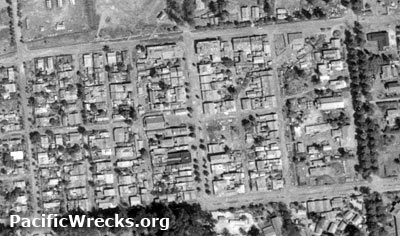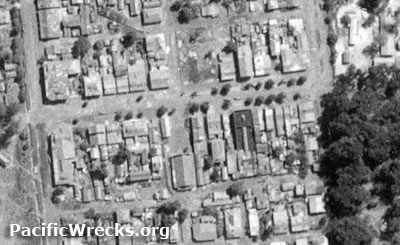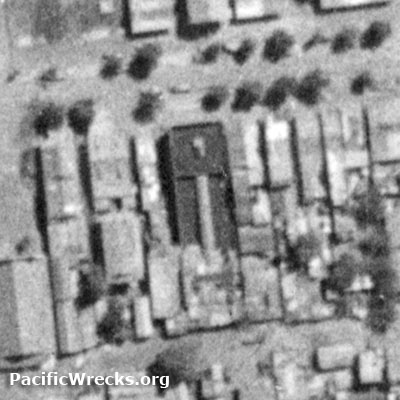|
|
|
|
| Missing In Action (MIA) | Prisoners Of War (POW) | Unexploded Ordnance (UXO) |
| Chronology | Locations | Aircraft | Ships | Submit Info | How You Can Help | Donate |
|
   5th AF c1943 |
Location The Rabaul Prisoner Compound was located in a prewar wooden building in the Chinatown area of Rabaul on the corner of Casurine Street and Konbue Street, between the Pacific Hotel and Malaguna Road. Also known as Rabaul POW Camp, Rabaul POW Prison, Kempei Tai POW Prison or 6th Field Kempi Tai Headquarters Prisoner Of War Camp. Prewar This building was built as a two story wooden building. In the early 1940s, owned by a Chinese businessman named Akun who operated a tailor shop and clothing store from this location. The side facing the street had a storefront and behind the front building was a court yard. Wartime History On January 23, 1942 this building was captured by the Japanese when they captured Rabaul. The fate of the Chinese owner Akun is unknown. In early 1943, occupied by the Imperial Japanese Army (IJA), 6th Kempeitai (6th Kempei-Tai) / 6th Field Kempeitai (6th Field Kempei-Tai). The ground floor was converted into six cells to detain prisoners. The Japanese officers lived on the second floor while the prisoners were detained in six cells at ground level in the northern building with guard quarters in the southern building. Previously, Allied Prisoners Of War (POW) were detained elsewhere including the Imperial Japanese Navy (IJN) Keibitai Headquarters at Rabaul (Rabaul Navy POW Compound) and civilians detained elsewhere. Between early 1943 until early 1944, converted into a prison compound to detain Allied Prisoners Of War (POW). 1st Lt. Jose L. Holguin recalls: "The building housing the prisoners and the officers and men of the, military police headquarter were a series of converted, two story warehouse that before the war had been part of a Chinese tailor shop and clothing store. The officers, interpreters and warrant officers lived on the second floor, the prisoners were confined in six cells located on the lower floor of the northernmost building. The guards had their quarters in the southernmost building." Horio You Next Die! page 57: "The new prisoners [Joseph G. Nason and William Welles] were led into a dirt courtyard immediately behind the storefront. It was closed in on all sides by low, one story structures. Nason and Wells were directed towards the left one which had six evenly spaced doors along its length. To the right of each door was a small, waist-high window opening with bars, and below each of these at floor level was a smaller opening - about six inches high and twelve inches wide. Directly in front of this cell block was a three sided, open shelter, where two guards sat on a bench facing the cells." Known Prisoners Of War (POWs) detained at the Rabaul Prison Compound:
single tunnel guarded by 6th Kempeitai (6th Kempei-Tai) guards. Afterwards, the Rabaul Prisoner Compound buildings were either destroyed by U.S. bombing or deliberately burned down by the Japanese. Today During 1994, Rabaul largely destroyed by a volcanic eruption that covered most of the town in ash, including the location of this building. References E&E Report Gordon Manuel Appendix 1, page 3 "Australian and American prisoners of war are housed in the house of Akun on Casarina Avenue between the Pacific Hotel and Malaguna Road in Rabaul." Testimonial of Jose Holguin (1948) by Jose Holguin "Upon my arrival at the Sixth Field Kempei Tai Headquarters Prisoner of War Camp, Rabaul, New Britain, on or about 30 July 1943... On the night of 1 March 1944., we were ordered out of our cells, blind-folded, lined up, handcuffed in pairs in a column of twos and then the handcuffs were wired through the column line. The guards then marched Us to what seemed to be a large shelter not too far from our cells where we stayed until about 0900, 2nd March 1944. However, nothing happened, so we were returned to our cells. We received no food except a small bag containing 40 small biscuits. One bag was to provide for two men. Each man had 20 biscuits.. At about 0930 on the morning of 2 March 1944, I had just finished eating my biscuits when the siren sounded. We were called out and were sent back into the shelter, however, this time we were not blind-folded. In about 20 minutes bombers hit and bombs were dropped on one side of the shelter and other bombs hit on the other side of the shelter and on the buildings that we had previously occupied. When we came out of the shelter everything was an fire. The Japanese were making some kind of an attempt to put out the flames. About an hour after the air raid, we were marched a short distance from the, shelter where we waited until 1300, during which time the Japanese were busy evacuating themselves from the area that had been bombed, Later in the day and about 1830, 2 March 1944, the Japanese guards loaded us into a truck and we departed from the area of Sixth Field Kempei Tai Headquarters, Prisoner of War Camp, Rabaul, New Britain. The truck arrived at Tunnel, Hill Prisoner of War Camp Cave, Rabaul, New Britain. about 1915 hours on 2 March 1944." Horio You Next Die! (1987) by Joseph G. Nason page 57 Hostages To Freedom The Fall of Rabaul (1995) by Peter Stone pages 296 (map) Target Rabaul (2013) by Bruce Gamble (6th Field Kempeitai) pages 47, 51, 122, 266, 327-328, 334, 339, 352, 357, (Appendix A - The Prisoners of Rabaul) 363 Thanks to Henry Sakaida and Brian Bennett for additional information Contribute
Information Last Updated
|
Photo Archive |
| Discussion Forum | Daily Updates | Reviews | Museums | Interviews & Oral Histories |
|